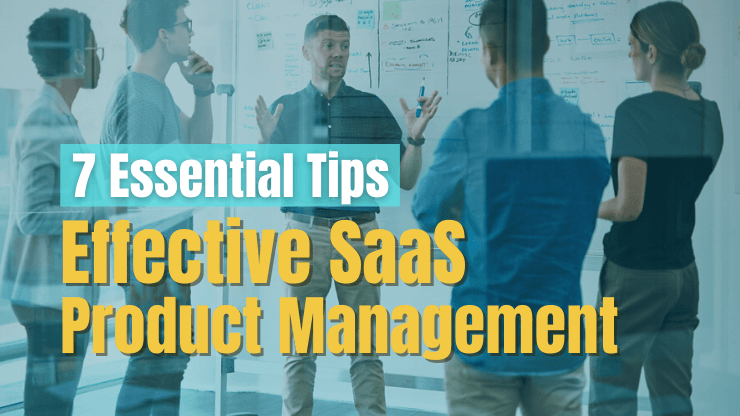According to recent research, based on input from over 2,500 product managers around the world, the biggest challenges in SaaS Product Management are:
- Setting roadmap priorities
- Getting consensus on product direction
- Working with other departments
- Prioritizing initiatives
- Communicating product strategy
To tackle these challenges as a SaaS product manager, it's important to understand and apply the right frameworks and tools.
In this article, we’ll walk you through 7 of the most essential tips to master SaaS product management, as well as provide you with a shortlist of must-have product management tools. Read on to learn how to make the most of your SaaS product strategy and stay ahead of the curve.
What is SaaS product management?
SaaS product management is the process of overseeing the development, launch, marketing and improvement of software-as-a-service (SaaS) products throughout their life cycle.
It involves a wide variety of tasks, from researching and charting product visions, to sharing and communicating those visions with stakeholders, developing a strong product roadmap, interviewing customers, analyzing usage data, and improving long-term customer satisfaction.
SaaS product managers (PMs) need to have an understanding of the company’s product, market, target audience, user personas, statistics, and competitors in order to be successful. Through all of these tasks, a product manager strives to ensure their product is successful in the market.

Responsibilities of a SaaS product manager include:
- Setting strategy: A SaaS product manager owns the overall product strategy and casts the product vision by communicating the product's purpose, goals, and roadmap to the team, customers, and other stakeholders. They should be able to articulate the problem the product is solving, the value the product delivers, and the progress that has been made towards meeting sprint or other roadmap milestones.
- Ensuring customer success: Above all else, a SaaS product manager must prioritize customer success. They often work with a formal customer success team to set customer success KPIs, analyze customer satisfaction, and develop a plan for improving and sustaining customer success long-term.
- Planning the product roadmap: A SaaS product manager is responsible for defining the long-term roadmap and, alongside the development leads, breaking it down into achievable goals and milestones.
- Analyzing usage data: The SaaS product manager needs to stay close to the existing customers, gather their feedback, and use it to inform product design and development decisions. This includes analyzing usage data to identify opportunities for product improvement and feature optimization.
- Conducting market research: A SaaS product manager is responsible for conducting market research by analyzing industry trends, reviewing competitor offerings, and keeping up to date on relevant new technologies.
Why does SaaS product management matter?
SaaS product management is the key to creating and sustaining successful SaaS solutions. SaaS product managers oversee the entire product lifecycle, from the conception of the idea to the launch of the product and all the way through the long-term evolution of the product.
Proper SaaS product management helps to ensure that the SaaS solution meets customer needs, satisfies user expectations, and retains customers long-term. The product management process is complex and involves collaboration with a variety of teams along with deep technical and business skills. Because of this complexity, SaaS product managers are up against some challenges, including:
- Finding the right subscription pricing structure
- Keeping up with evolving user expectations and demands
- Ensuring scalability long-term
- Getting consensus on product direction across stakeholders
- Planning and prioritizing feature development
PRO TIP: It’s important to know that SaaS product management differs in a few key ways from traditional product management. Most notably:
- Instead of infrequent, large scale product launches, the focus is on frequent, small feature launches.
- The go-to-market strategy is focused on a subscription-based pricing model, where recurring revenue is one of the primary key performance indicators (KPIs).
- There is a focus on creating a product that promotes a high degree of customer retention and loyalty rather than simply customer acquisition.
7 essential tips for effective SaaS product management
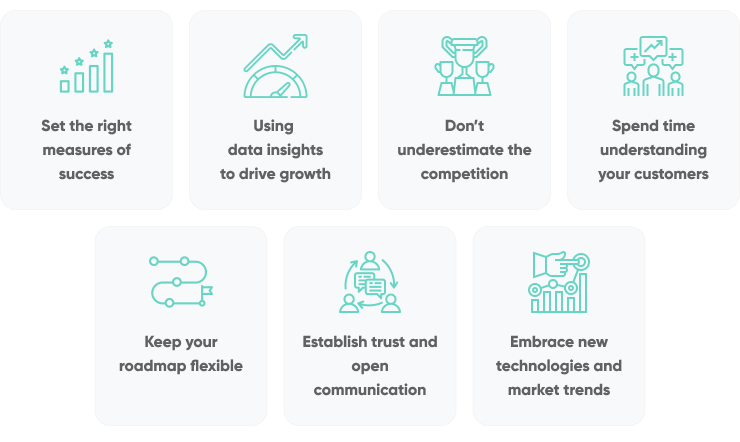
SaaS product managers play a pivotal role in a SaaS company's success, and it's important they have the right skills and knowledge to ensure their product stands out in the competitive marketplace and retains customers long-term.
To help you do just that, in this section we will provide 7 tips that will help you ensure your products are successful. Let’s get started!
Set the right measures of success
There’s no doubt that SaaS product management requires a keen eye for data analysis, but to maximize your data analysis work you need to make sure that you’re tracking the right metrics. It’s a good idea to have an open conversation with your chain of management as well as the greater product team to collectively decide how to measure success.
Consider metrics such as:
- Net Promoter Score (NPS): Used to measure customer satisfaction and loyalty, based on a single question survey asking customers how likely they are to recommend a product to a friend or colleague on a scale of 0-10.
- Customer sentiment: The emotional reaction of customers to a product or service. This metric can be measured through surveys and ratings, as well as through online conversations and reviews.
- Customer retention: The percentage of customers who continue to use a product or service over time. This metric is typically measured on a monthly or quarterly basis.
- Monthly recurring revenue: Revenue from customers that is predictable and recurring, such as subscription fees.
- Platform usage: The amount of time customers spend using a product or service, or how often they access it.
- Feature-specific adoption: The percentage of customers who are actively using a specific feature or set of features within a product or service.
Using data insights to drive growth
To stay ahead of the curve in the SaaS space, it is important to have strong data analysis skills. In fact, data analysis is one of the most important skills for SaaS product managers. Take the time to invest in your ability to effectively query data from relevant databases as well as understand how to segment and analysis your product data.
Here are some tips to hone in on your data analysis skills:
- Utilize the AARRR framework to identify and track relevant data points.
- Brush up on your data analysis skills, so you can quickly pull knowledge out of data.
- Work with the marketing team to appropriately segment your current and potential customers, allowing you to conduct segment-specific data analysis and pull more helpful insights.
- Get creative with data visualizations to make the data easier to understand, interpret, and communicate to other teams.
Don’t underestimate the competition
SaaS markets move at a fast pace, with new products being released constantly and existing software solutions releasing new features on a near continuous basis. It’s critical that SaaS product managers do not make any assumptions about their competition’s product strategy or ability to outperform them.
Every SaaS product manager should stay vigilant and remain apprised of their competitors’ product evolution. Doing so can help SaaS product managers gain valuable insights about the market, identify key opportunities, and stay ahead of the competition.
Best practices for competitive research include:
- Track competitors’ new features, pricing models, and marketing strategies, specifically look for information related to their long-term product strategy to understand what you’ll be up against in the coming months and years.
- Monitor competitors’ customer reviews and feedback to learn how customers are perceiving the company’s products and brand.
- Read competitors’ press releases, blog posts, and other announcements to understand how the software solution is being positioned to their target audience.
- Regularly search for competitors’ content on social media and learn from their strategies and positioning tactics.
Spend time understanding your customers
As a SaaS product manager you should be frequently interacting with your customers to understand their perception of your product, their preferences about software enhancements, and how they use your product, among other things. These insights can help you ensure your SaaS product is tailored to your customers’ needs and provides the best user experience possible.
Gathering this kind of information from customers can be done through surveys, interviews, and requests for feedback. Here are some tips for prioritizing customer input to ensure effective SaaS product management:
- Utilize customer input surveys to gain anonymous insight into customer needs and preferences.
- Conduct informal, frequent customer interviews to assess customer demands. Make time for this kind of direct customer interaction on at least a weekly basis.
- Establish meaningful customer contacts with early adopters or power users who you can rely on to provide honest feedback about your product.
- Monitor customer input channels such as social media, forums, and other online platforms to understand how your users are responding to your brand publicly.
PRO TIP: Organize feedback by groups such as customer segment, cohort, or demographics to more understand your customers in a more nuanced way. Use this data to inform not just short term changes to your product but also long-term roadmap development.
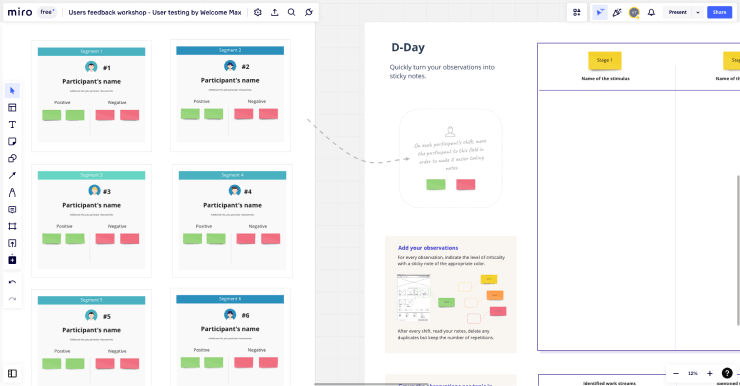
Keep your roadmap flexible
SaaS product managers should prepare for continual changes in the market, customer needs, and technology trends by planning their product roadmap with agility in mind. This means that the roadmap should be open to evolving and changing as the market and customer needs shift.
This means that you must be prepared to make changes to your roadmap, including adding new features, removing existing ones, and adjusting timelines as new information becomes available. Here are some tips as you keep your roadmap flexible:
- Leverage data and customer input: Use data from customer surveys, usage metrics, and other sources to inform changes to the roadmap.
- Prioritize customer needs: Make sure that customer needs are at the forefront of all decisions and that you prioritize customer input when making changes.
- Consider the impact of changes: Before making any changes to the roadmap, consider the impact of those changes on the customer experience and the overall product.
Establish trust and open communication
Product management is inherently collaborative and cross-functional. It demands every product manager establish trust and open communication with software development, product marketing, and sales teams.
One of the key responsibilities of a SaaS product manager is to take the time to develop a product management process that prioritizes consistent and transparent communication. Doing so can help every product manager understand each team's goals and how they align with the product's strategy. We recommend you:
- Set the standard for open communication by proactively and consistently communicating your product vision, roadmap, and upcoming feature releases to all relevant team members.
- Ensure everyone has access to necessary resources such as the roadmap, sprint plans, and competitive analysis.
- Initiate conversations with members on the entire product team to better understand each person’s contribution to the product success, their concerns, priorities, and preferences.
Embrace new technologies and market trends
As a product manager at a SaaS company, it is essential to be aware of and embrace new technologies that can help to improve your product and increase customer satisfaction. Embracing new technologies can help to ensure that your product stays up-to-date and is in-line with customer trends and expectations. Here are some ways to effectively embrace new technologies:
- Attend industry conferences and networking events to stay up-to-date on new technologies and market trends within your industry.
- Subscribe to industry newsletters and stay engaged with thought leaders in the space.
- Research, evaluate, and test new technologies that can be used to improve the product features and user experience.
- Analyze customer feedback and assess the potential of new technologies to solve customer needs and improve user experience.
- Develop a process for vetting and trialing new technologies, and establishing criteria for selecting the best ones for product integration.
Must-have tools for SaaS product managers
As we have seen, the role of a SaaS product manager is complex, involving skills in project management, data analysis, product strategy and more. For this reason, it is critical to have the right software tools to help enable a successful product development process.
The right software tools can provide a SaaS product manager:
- Increased efficiency: Using the right software can help a SaaS product manager to automate tasks and streamline processes, opening up more time to focus on more important tasks such as conducting customer interviews or working on long-term strategy.
- Improved collaboration: The right software can help product managers to collaborate more effectively with their team members and stakeholders. This includes better communication, better task management, and improved reporting.
- Increased visibility: The right software can help product managers to gain greater visibility into their product's performance, allowing them to make better decisions about the product's roadmap and features.
Project management software
Let’s start with project management software, which is a must have tool for SaaS product managers, as it enables them to organize and manage projects more efficiently and effectively.
This essential software can help product management teams better communicate with the development team, establish clear goals and objectives, allocate resources, and provide visibility into the progress of development sprints.
Ways a SaaS product manager can use project management software:
- Create and assign tasks based on the roadmap and sprint planning
- Track progress of tasks and enforce deadlines
- Identify potential risks associated with tasks
- Generate reports on the progress of tasks
- Establish dependencies between tasks and asses priorities on the fly
- Establish communication with team members regarding tasks
RECOMMENDED TOOLS:
The most popular project management tools are Asana, ClickUp, Jira, and Trello. Each of these tools offers a suite of features and capabilities that can help product managers stay organized. Asana and Trello are both popular for their straightforward and intuitive user interfaces, while Jira is well-known for its robust set of development tools and integrations.
ClickUp is a newer tool that has quickly become the go-to choice for many product managers, thanks to its flexible and powerful feature set:
- A visually appealing and intuitive user interface that makes it easy to manage tasks and projects.
- A powerful search engine that makes it easy to find information quickly.
- Customizable views and workflows that allow you to tailor the software to your specific needs.
- Robust project management features, including Gantt charts, sprint planning, and resource management.
- Automation tools that help streamline processes and save time.
- Advanced reporting tools for tracking progress and performance.
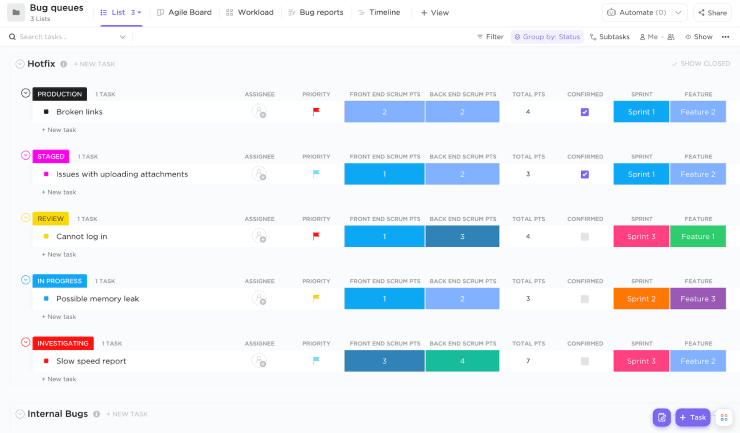
Analytics software
Analytics software is a data-gathering, processing, and reporting tool designed to extract and deliver meaningful insights from data. It is an incredibly powerful tool for SaaS product managers, allowing them to monitor customer behavior, understand customer preferences, track customer engagement, and optimize product performance.
Ways a SaaS product manager can use analytics software:
- Monitor customer usage, engagement, and retention to help inform product strategy and identify opportunities for improvement.
- Identify areas of customer confusion and frustration, so that a product manager can respond quickly and address issues.
- Measure the effectiveness of product features, so that PMs can determine which features should be prioritized and which should be deprioritized.
RECOMMENDED TOOLS:
The most popular analytics tools for SaaS product management are Heap, Amplitude, and Mixpanel. Each of them provides a broad range of features for tracking and understanding user behavior, including funnel analysis, A/B testing, and segmentation.
Which one should you use? It depends on what type of user behavior you are looking to track:
- Heap is well known for its ease of use, allowing you to track user behavior quickly and easily with integrated session replay.
- Amplitude is great for tracking more in-depth user activity and can provide you with deeper insights.
- Mixpanel is a powerful tool and can track more complex user behavior, but it can be more complicated to set up.
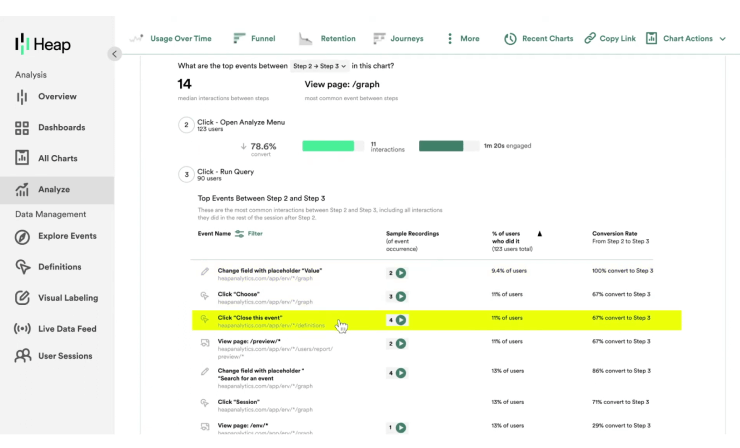
A/B testing tools
A/B testing tools are used to compare two different versions of a UX design, feature or other element of your product. This allows SaaS product management teams to make informed decisions regarding changes or improvements to their product, based on real user data, helping to keep customer satisfaction at the forefront of decision making.
Ways a SaaS product manager can use A/B testing tools:
- Identify which features customers find most valuable
- Optimize product features and user experience
- Test new product designs
- Identify issues in the user flow
- Analyze user feedback and make improvements
- Establish better customer segmentation
RECOMMENDED TOOLS:
If you are using Heap or Amplitude for SaaS product management, you may not need specialized A/B testing tools such as VWO or Optimizely. However, these specialized tools offer features that are not found in Heap or Amplitude, including:
- Visual editor - allows you to quickly make changes to the user interface, including adding or removing elements, changing colors and fonts, and more.
- Optimization algorithms - allow you to test multiple variations of a page or feature to determine which one performs best.
- User segmentation - allows you to target different user groups with different variations of a page or feature.
Collaboration tools
Collaboration tools are software applications that enable teams to work together in a collaborative environment. These tools are essential for SaaS product managers as they allow teams to break down complex tasks, post updates, and collaborate easily and quickly. Every SaaS product management team needs collaboration tools to make decisions quickly and accurately, streamline communication, and stay on top of product changes with ease.
Ways a SaaS product manager can use collaboration tools:
- Share product updates and new feature releases with the team
- Create channels to discuss product ideas and brainstorm solutions to challenges
- Streamline customer support inquiries by creating a channel for customer service representatives
- Share project progress and timelines to ensure everyone is on the same page and working towards their goals
RECOMMENDED TOOLS:
The recommended tools for SaaS product management teams are Slack and Microsoft Teams. Both of these collaboration tools are designed to help teams communicate more efficiently, stay on top of product updates, share project progress and timelines, and brainstorm ideas:
- With Slack, you can create channels for specific topics, set up notifications for new messages, and quickly search for relevant conversations.
- Microsoft Teams has similar features, plus it allows you to host video conferences and share documents.
Both of these tools are great for keeping teams organized and on the same page, making them essential for any SaaS product management team.
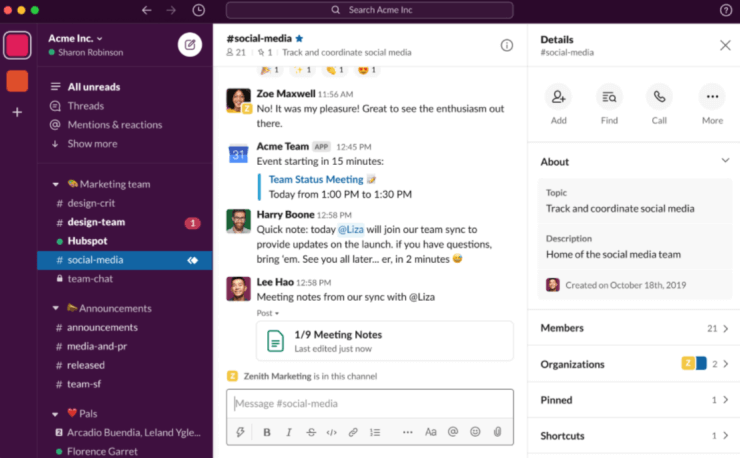
Prototyping tools
Prototyping tools are used to create a facsimile of your SaaS product, that can be tested and shared with stakeholders to gain feedback and approval. It is a must-have tool for SaaS product managers as it allows them to quickly test ideas and create a tangible, interactive representation of a product before investing in development.
Ways a SaaS product manager can use prototyping tools:
- Create user interfaces and user flows to get feedback on user experience
- Prototype new features to test user reactions
- Design product mock-ups to communicate ideas to stakeholders
- Create wireframes to visualize product interaction flows
RECOMMENDED TOOLS:
The recommended prototyping tools for SaaS product managers are:
- Balsamiq - simple wireframing tool that allows any member of your team to quickly and easily create sketches to facilitate discussion and understanding, before you engage in creating high-fidelity designs.
- Figma - tool that can be used to create interactive prototypes that simulate the user experience, helping to ensure that the product meets customer expectations.
Both tools allow your team to create a library of components and collaborate with others in real-time to make changes, add comments, and refine designs.
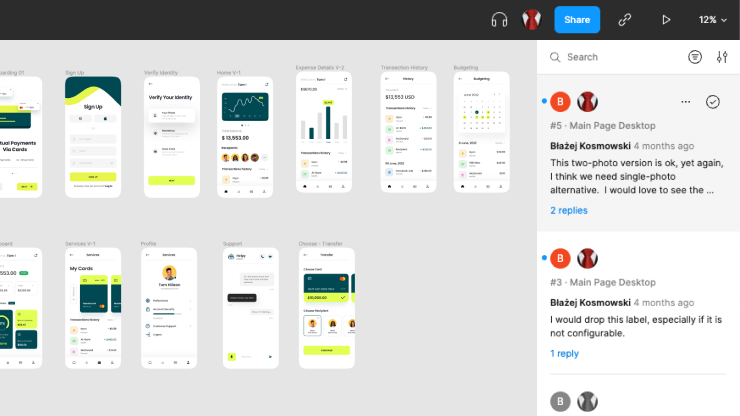
Bug tracking software
Bug tracking software is used by software development and product management teams to manage and track the software bugs that are found during the development process. It helps product managers to identify, prioritize and resolve software issues quickly and efficiently. This type of software is essential for product managers working on SaaS products, as it allows them to keep track of any issues that have been found by customers or internal teams and make sure that they are addressed in a timely manner.
Ways a SaaS product manager can use bug tracking software:
- Identify and prioritize high-priority bugs
- Monitor progress of bug-fixing efforts
- Assign tasks to developers based on bug severity
- Estimate time needed to fix a bug
- Create reports on bug trends over time
- Track bug-related feedback from customers
- Identify areas of improvement for the product
- Analyze bug-related data for roadmap decisions
RECOMMENDED TOOLS:
Clickup can be used for bug tracking along a regular roadmap for SaaS product management by tracking each bug's progress and assigning tasks to members of the team to ensure that bugs are handled along with new feature development activities.
Some bug tracking features Clickup offers include:
- Custom labels to indicate the severity of the bug, the priority of the bug, and any other relevant information
- Checklists and automated workflows to ensure that tasks related to bug resolution are followed accurately
- Project boards and reports to get an overview of bug resolution progress
- Gantt chart view to track bug resolution over time
![]()
Customer feedback tracking tools
Customer feedback tracking tools are software tools designed to help PMs and other stakeholders collect, store, and analyze customer feedback data. This type of tool is essential for product managers as it helps them better understand customer sentiment and preferences, track changes in customer sentiment over time, and prioritize new product features and enhancements based on this data.
Ways a SaaS product manager can use bug tracking software:
- Monitor customer sentiment over time to identify trends and inform product development plans
- Analyze customer reviews and feedback to determine which features need improvement
- Identify customer pain points, prioritize feature requests and address customer needs
- Measure customer satisfaction and identify areas for improvement
- Generate reports to help product teams better understand customer feedback
- Track feedback across multiple channels for a holistic view of customer feedback
RECOMMENDED TOOLS:
The most popular tools for SaaS product management are Craft.io, ProdPad, and Canny:
- Craft.io is designed to help product managers visualize their product roadmap, track customer feedback, and prioritize features.
- ProdPad is a product management platform that helps teams capture customer insights and prioritize features.
- Canny is a customer-centric product feedback platform that helps product teams collect, organize, and prioritize customer feedback.
All of these tools allow product managers to better understand customer needs, prioritize features, and measure customer satisfaction.
![]()
What does it take to be a successful SaaS product manager?
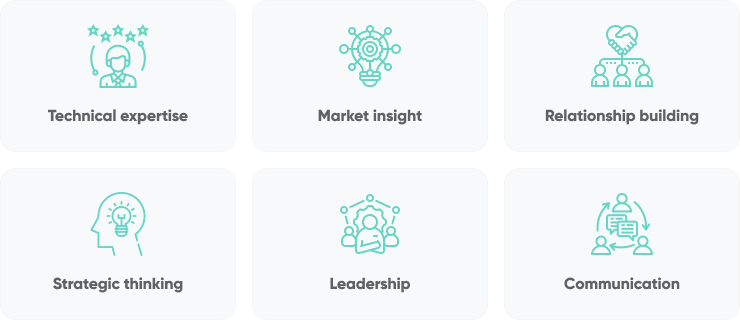
So far we’ve provided advice for mastering SaaS product management as well as a list of key tools you should have in your arsenal as a PM. Because the work of a product manager is so interdisciplinary and requires interfacing with a wide variety of teams from software development to marketing, you need to cultivate an equally well-rounded set of skills during your career. So let’s round things out by highlighting some of the key soft skills and technical skills that are needed if you want to be a successful SaaS product manager:
- Technical expertise - While it’s certainly not required to have the level of technical expertise as say, a software developer, a successful SaaS product manager needs to have a strong technical understanding of the underlying platform and technology that powers their product.
- Market insight - A SaaS product manager should be well-versed in the latest market trends and customer needs to ensure their product meets the demands of the market. They should be able to analyze customer data and feedback to identify gaps in the market, and develop strategies to fill those gaps with their product.
- Relationship building - A SaaS product manager needs to be able to build relationships with stakeholders, customers, and partners in order to understand their needs and facilitate the development of the product. They should be able to effectively communicate their vision for the product and collaborate with stakeholders to ensure it is successful.
- Strategic thinking - A SaaS product manager should be able to think strategically to ensure the product is developed in a way that maximizes its potential. This includes identifying opportunities for growth, developing strategies for achieving those objectives, analyzing customer segmentation and prioritizing features and enhancements to ensure the product is tailored to the customer’s needs.
- Leadership - A SaaS product manager needs to be able to effectively lead a team and ensure they are working together to develop the product. This includes being able to delegate tasks, provide clear direction, and motivate the team to hit their goals.
- Communication - A SaaS product manager needs to be able to communicate product updates, feature requests and customer input to the team and stakeholders. Additionally, they should be able to use data to communicate the value of the product and the impact it is having on the customer’s experience.
Conclusion
SaaS product managers play a pivotal role in their company's success, and it's important they have the right skills and knowledge to ensure their product stands out in the competitive marketplace.
In this article we have provided 7 tips that will help SaaS product managers focus on the right metrics, choose the right tools, and cultivate the right skills, so they can ensure the long term success of their product and be well on their way to true product leadership!
If you're looking for a software development partner, don’t hesitate to reach out for a consultation. With our SaaS application development services you can accelerate your software product development, meet tight market-windows, and exceed customer expectations.

